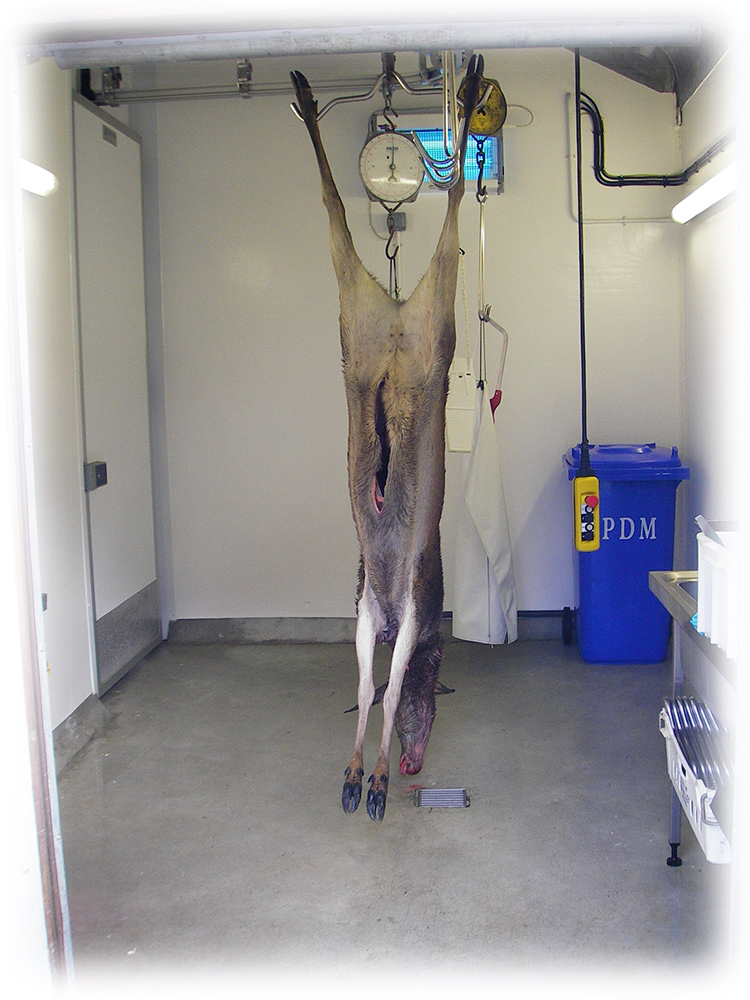
Safety and hygiene
Introduction
Even the best larder could produce unhygienic carcasses or be dangerous if incorrectly used. The aim of this guide is to describe how to maintain a hygienic environment in which to larder carcasses and protect personal safety. This guide links to Basic Hygiene, Waste Disposal, and Carcass inspection guides.
Safe working
Working safely in a larder is largely a matter of common sense. A simple risk assessment (see Risk Assessment guide) should highlight the hazards and their controls, some of these are:
Hazard | Control |
| Injury caused by lifting | Use winch, especially for heavy carcasses. Avoid over-filling waste bins or get help |
| Slipping/tripping | Keep floor clear of obstructions/slippery material. Maintain non-slip properties of floor |
| Injury from overhead equipment | Avoid use of sharply pointed “S” hooks/gambrels and keep them above head/eye height where possible. Wear hard hat if appropriate. |
| Injury from knives/saws | Use equipment only for the purpose for which it was designed and do not use excessive force. Keep non-cutting hand clear of cuts and wear a protective glove. Take care when moving around larder. Keep equipment not in use in a safe place e.g. knives in scabbard or steriliser, not lying on floor or in a water filled bucket |
| Injury from carcasses | Be aware of antlers, hooves and sawn/broken bones as sources of injury |
| Infection from equipment, surfaces, carcasses or waste | Keep all surfaces/equipment clean. Avoid known sources of infection during carcass inspection/isolation. Avoid unnecessary contact with carcass waste. Wash down protective clothing and clean exposed areas of skin at end of working. Protect wounds with clean plasters(blue) and /or wear gloves(change them when soiled) |
| Injury/poisoning from chemicals | Use cleaning chemicals only as advised by the manufacturer |
Hygiene and cleaning
Basic hygiene and HACCP principles should be applied to working in the larder (see Basic Hygiene guide, and Further Info below)
Prior to use:
The larder should be in a clean state having been through the end of session or deep clean procedures described below.
Dirty carcasses (mud and other soiling) should not be brought directly into the larder but the hide washed down before entering, taking care not to contaminate breaks in the skin such as the sticking point, bullet wound and gralloching cuts.
During use:
Do not allow blood, waste material and hair to build up on surfaces or equipment as carcasses are processed.
Ensure that the larder floor/walls and ‘in-use’ knives and scabbards are visibly clean between dressing each carcass or when heavily soiled. Avoid splashing carcasses as you clean.
Place waste, including heads and legs, in impervious containers with well fitting lids. Mark these containers ‘Not fit for Human Consumption’.
At the end of session:
Record carcass details and keep safe.
Hose down walls, floors and equipment to remove visible waste.
Using fat-dissolving food-approved detergents and disinfectants approved for food use to clean surfaces, larder hardware and protective equipment such as aprons and chain mail gloves.
Sterilise knives, saws and scabbards using recommended methods (water at 82ºC, Ultra violet light cabinets or Steri-wipes -can also be done during use).
Empty and disinfect drainage traps.
Wash down area outside larder door.
Empty, wash and disinfect waste containers.
Turn lights off.
Ensure temp control is working and that there is adequate ventilation.
Complete cleaning and temperature records as required
Deep clean
(Periodically and especially when the larder will not be in use for a while):
Empty the larder of carcasses.
Carry out an “end of session” clean but ensure that in addition, all nooks and crevices are hosed down with a low pressure hose and disinfected.
Wash and disinfect all equipment including hooks, gambrels, hoist.
Disinfect and wash down the outside area.
Turn off temp control but allow free ventilation (while excluding vermin) to ensure that the larder dries thoroughly.
Complete cleaning record as required.
Personal hygiene
Do not enter the larder or dress carcasses if you (or others you have contact with) have food poisoning or if you have septic lesions that cannot be covered, or any other disease likely to be transmitted to the carcass.
Wash down and disinfect footwear before entering the larder or change into dedicated footwear.
Wear clean, washable, light-coloured, protective over-clothing such as an apron.
Cover any wound with a clean waterproof, food safe(blue), plaster or wear disposable gloves that are changed when soiled.
Wash hands, before working on each carcass or after touching anything that is potentially contaminated.
Remain aware of the need to maintain high standards of personal hygiene throughout the whole process.
Do not eat, drink or smoke in the larder.
Temperature control and ventilation
When new carcasses are brought into the larder the temperature may rise, this is inevitable in the preparation area but the effect can be reduced in the storage area by allowing carcasses to cool before transferring them. Temperature should be checked every 24 hours when the storage area is in use.
Records
Records should be kept of carcasses passing through the larder ( see Record Keeping and Cull Planning guides) Larder maintenance records are useful, the level of record keeping should be linked to the scale of the processing operation, however, for HACCP purposes a cleaning record should be maintained and a temperature record is advisable.
Security
It may be necessary to secure the larder and/or it’s immediate area against theft, vandalism or contamination by non-authorised use. The larder should be secure against entry by mammals, birds and insects.
Further Info
https://www.fsai.ie/food_businesses/haccp/principles_of_haccp.html